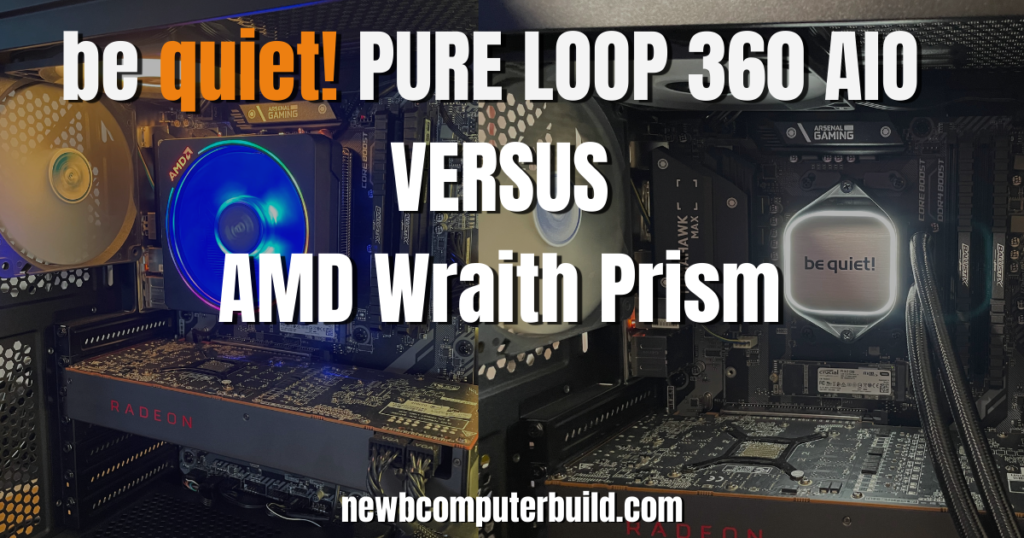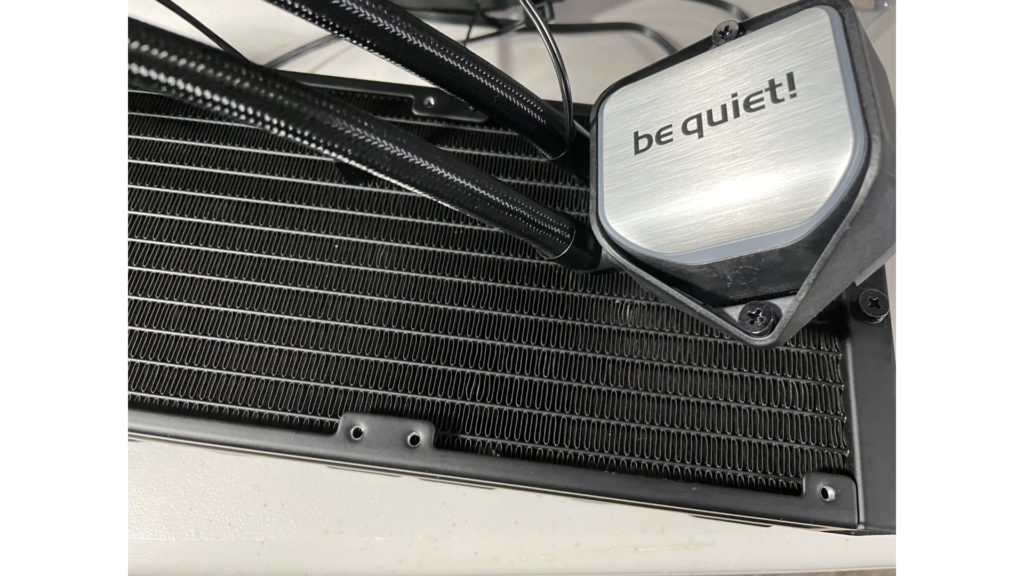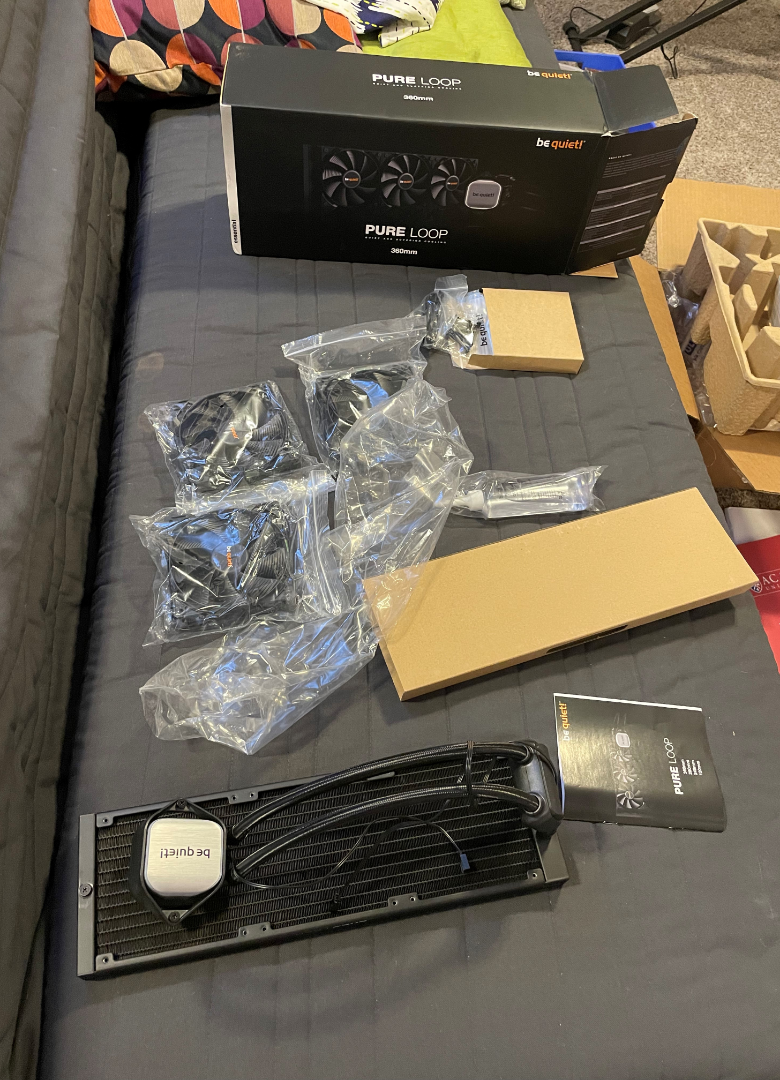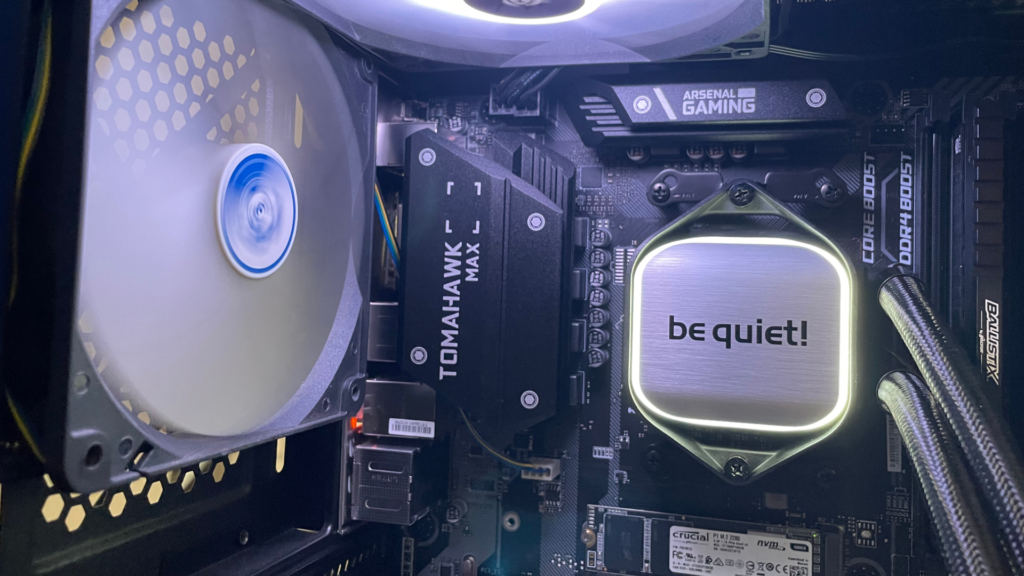
Today I’m taking a looking at the Pure Loop 360mm AIO from be quiet!. I’ll dive into a bit of an overview of the AIO, and then I’ll be running through a few tests and ultimately comparing it to my Ryzen Wraith Prism Stock Cooling (the stock AMD cooler that came with my Ryzen 3700X), to ultimately answer the question of is it worth upgrading my stock cooler?.
This is usually a question many first-time PC builders ask when building their first PC, and for good reason. In this case, we are comparing specifically the stock cooler that comes with any of the Ryzen 3900x, 3800x and the 3700x and the usual answer is something like “it depends on what you plan on doing and whether or not you plan on overclocking”.
So today we will do just that, do a suite of tests comparing the stock AMD Wraith Prism Cooling to the be quiet! Pure Loop 360 — answering the question, to AIO or not to AIO!
And for the tests, I’ll be comparing each cooler with the CPU (Ryzen 7 3700X) at default settings and then using Precision Boost Overdrive (an opportunistic automated overclocking mechanism found on newer AMD processors) applied and measuring CPU Average temps using Prime95 (20 minutes Torture Test) to stress the CPU through a couple of runs and using HwINFO to benchmark the temperatures. Then, I’ll do some Cinbenech tests to see if this has any effect as well. In the end, you should have a decent idea as to whether to not you should consider an All In One Liquid (AIO) CPU cooler versus your included stock CPU cooler.
So the Pure Loop tests will include:
- Temperature Measurement in Celcius at Default CPU settings at Idle
- Temperature Measurement in Celcius with Default CPU Settings at 100% Load using Prime95
- Temperature Measurement with Overclocked CPU using Precision Boost Overdrive at Idle
- Temperature Measurement Overclocked with Precision Boost Overdrive at 100% Load using Prime95
The Pure Loop 360mm AIO and be quiet! – Overview and What’s Included
The Pure Loop 360mm AIO comes with three 120mm Pure Wings 2 fans and is one of the two categories of AIO Water Cooling currently available from be quiet!, the second is their Silent Loop 2 Series of AIO’s. However, apparently, if you live in the US, procuring the Silent Loop 2 may not be possible at the moment according to this video by C.D. Reimer, which boils down to how be quiet! placed the pump on the newer Silent Loop model — which has to do something with patent warranties in the US.

And for those of you who don’t already know, be quiet! is a well-known enthusiast PC company known for making PC cooling under the slogan of “no compromise silence and performance”, which is what I like most about be-quiet!, as they are a no-frills sort of PC brand that focuses purely on what matters. In this case, the 360mm Pure Loop being a high-performing all-in-one water cooler with silent operation — specifically for price-conscious buyers.
The Pure Loop was released less than a year ago and supports all current desktop CPUs from Intel and AMD, except for AMD Threadripper. What’s handy, is that it also comes with a refill port and a 100ml bottle of coolant, so if ever needed you can top up your AIO (which be quiet! recommends you do every 2 years).
The full breadth of what’s included aside from the radiator, fans and pump itself, is all of the hardware for wither an Intel or AMD install, the top-up bottle of coolant, all screw hardware, a SATA power adapter for the pump and LED on the AIO, a three-way 4-pin PWN fan splitter cable and some thermal compound (which I used).

In terms of cost, the 360mm Pure Loop has an MSRP of $119.99, and at the time of writing this article is also the cost that you can purchase this AIO for on Amazon. You can also get two other sizes in the Pure Loop series of AIO’s, which is a 240mm Version for $94.90 (two 120mm) fans or a 280mm version for $104.90 (two 140mm fans).
Comparing the Pure Loop simply in terms of cost to other AIO’s, it’s currently within the top 12 most affordable 360mm AIO’s in the US (according to PC Part Picker), so definitely affordable for those looking for an all-in-one liquid cooling solution.
So now the question is, should you get an affordable AIO to replace your current stock cooling, and we’ll be answering this question today using the results of the tests that were outlined earlier in this article. That is, by running some CPU stress tests while the CPU is at stock setting, and then overclocking settings and then pushed to 100% loads.
Testing the be quiet! Pure Loop 360mm AIO
Each of the tests I ran is seen below and is measured in degrees celsius running the Ryzen 7 3700X CPU on full load, while also comparing to the CPU at Idle. The be quiet! PURE LOOP also has all of its fans running at 100% for the sake of this test and ambient temperature is at around 20 degrees celsius (+ or – a degree).
The test setup is being done in a fully enclosed case with the following setup:
- CPU: Ryzen 7 3700X
- Cooling: Either the Wraith Prism Stock Cooler or the be quiet! Pure Loop 360
- GPU: AMD 5700
- Memory: 16GB Crucial Ballistix MAX 4000
- Case: Corsair 175R

As you can see, this is a fairly standard mid-range PC build, that hopefully gives you a good idea as to what to expect if you’re considering upgrading to an AIO. The be quiet! Pure Loop is slotted as one of the more affordable options, and be quiet! even states that it’s a choice for price-conscious consumers.
be quiet! Pure Loop versus Wraith Prism Performance Test
Here you can see the full suite of temperature tests while stressing my Ryzen 7 3700X on both its stock Wraith Prism Cooling and the be quiet!’s Pure Loop AIO. The first tests on the left are at default CPU settings on the 3700X, and then with Precision Boost Overdrive enabled.
You can see that at Idle, the be quiet! Pure Loop is 7.7 degrees Celcius better-using default CPU settings, which is surprising to me. And then using Precision Boost Overdrive it’s about the same at 7.4 degrees Celcius improvement. For Idle, I’m surprised as this is fairly significant. These tests, along with the stress tests all ran for 20 minutes,
Now, with the Ryzen 7 3700X CPU at default settings and stressing the CPU 100% using Prime95, you can see that the difference in temperature over a 20 minute time period is 8.4 degrees Celcius; very significant if you ask me. The Pure Loop in this case rang supreme without any issue. In this use case, I could argue the benefit of using this AIO over the stock cooler.
Now when I enable Precision Boost Overdrive, I got a 1.8 degree Celcius improvement, which was interesting. I would have actually thought this would have performed a bit better, although it was still better. Using PBO though, I actually had to run this test several times because my CPU actually would randomly hit 93 degrees celsius and I cannot explain why other than perhaps PBO thinking it had enough headroom to do so. This could have been the odd way I installed the AIO as I did place the fans and radiator on the front of my case in a push configuration, however, I suspect it had something to do with the pump in a certain stance. Either way, the Pure Loop still performed a tidbit better, although I can’t argue its improvement over stock cooling here.
Cinebench R23 Benchmarks
I also did some Cinebench R23 benchmarks, which were actually quite interesting and gives you a good look at what a “real-world” type benchmark that would perhaps utilize your whole CPU.
If you look above, you can see that using the Multi Cord benchmark with Default CPU setting on the Ryzen 3700X, it scored 177 points higher. While not hugely significant, it’s still an increase. For single-core performance, you can see that the performance gains were a little more minimal with only 12 points increase using default cpu settings, but using Precision Boost Overdrive it was 14, so not hugely different.
Where the major performance increase was with Precision Boost Overdrive using Multi-Core, which scored a total of 234 points higher. In my books, that’s decent.
Subjective Acoustics Test
This is a “be quiet!” AIO and this wouldn’t necessarily be a full review if I wasn’t to include at least a bit on acoustics. I started testing using a basic phone app to measure Decibels, however, I felt, in the end, the results just weren’t going to be worth sharing as they just weren’t valid.
So what I can tell you is that when compared to the stock Wraith Prism Cooler from AMD, the Pure Loop is for sure quieter; after all, it is an AIO. I did notice that other reviewers out there have stated that the pump itself made a certain noise, I however did not hear this.
What you do have to take into consideration though, is that the three fans on the radiator definitely make noise, and more so than the three fans I had on previously — which makes sense since they are blowing through a radiator. This isn’t necessarily noticeable on fan speeds below say 75%, but I was testing this at a full-throttle 100% and that gets a tad loud — more so than just the AMD stock cooler.
Overall, I would say it does a decent job at staying quiet — especially when using smart fan curves, so that they only speed up when they absolutely need to.
Final Words – Is the be quiet! Pure Loop 360mm AIO Worth Upgrading from Your Stock Cooler With?
Overall, I would say that the Pure Loop 360mm AIO is a good buy for those look for an affordable AIO solution. This is also considering that the AMD Wraith Prism stock cooler is actually also pretty decent and is one of the best stock coolers I’ve had come with any CPU ever in the first place, so if one were to actually stick with it, I wouldn’t argue against it. However, there were notable increases using the affordable be quiet! PURE LOOP AIO above. You can easily see that you can shave some temps off your maxes in comparison. What I didn’t include in this article were more extreme overclocks, which I am interested in, however, using PBO on my Ryzen CPU I think did the tests justice anyhow.
Some things to take into consideration are that I was using this cooler fully installed in my Corsair 175 budget PC case, along with having it installed on the front of the case. This meant that the fan configuration I used was on the opposite side of the radiator that be quiet! recommends. Now, this may have had minimal effect, I was not able to install it on the top of the case as there is;t enough room in the Corsair 175R.
This, however, does give the end-user a realistic perception as to what the improvement of an affordable AIO will give you in a fairly standard budget PC build — which is half the reason of this article as be quiet! is known for its price-conscious solutions.
What I am really curious about is whether or not the improvements of having an AIO like the be quit! PURE LOOP supersedes that of the newest AMD CPUs, such as the Ryzen 5600X, which only comes with a stock AMD Stealth Cooler (a lesser version of the wraith prism), where I actually may predict it would be way even more worth it too.
My ultimate recommendation is that you decide on whether you need to upgrade your cooler. In this instance, if you had the dollars I would consider upgrading to a be quiet! PURE LOOP, however, if you couldn’t afford it, all is not lost, even if you are considering some minimal overclocking.
Want to learn more about the bequiet! Pure Loop AIO – then visit be quiet!’s an overview of the Pure Loop or if you are interested in purchasing it, it’s currently on Amazon.com for $119.90 for the 360mm version.
Watch the Full Video Review of the be quiet! Pure Loop


